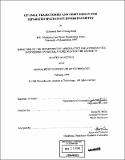| dc.contributor.advisor | David W. Miller. | en_US |
| dc.contributor.author | Kong, Edmund Mun Choong, 1973- | en_US |
| dc.date.accessioned | 2005-08-19T19:46:37Z | |
| dc.date.available | 2005-08-19T19:46:37Z | |
| dc.date.copyright | 1998 | en_US |
| dc.date.issued | 1999 | en_US |
| dc.identifier.uri | http://hdl.handle.net/1721.1/9730 | |
| dc.description | Thesis (S.M.)--Massachusetts Institute of Technology, Dept. of Aeronautics and Astronautics, February 1999. | en_US |
| dc.description | Vita. | en_US |
| dc.description | Includes bibliographical references (p. 153-156). | en_US |
| dc.description.abstract | Imaging of inter-stellar objects at angular resolutions that are beyond the capability of single aperture systems is made possible with the advent of the interferometer. Since the angular resolution of an interferometer is inversely proportional to the splatted of its apertures, angularly fine objects can only be detected using a separated spacecraft intelfercmeter (SSI). In order to maximize the return from such a system, this study addresses the optimal trajectories for a SSI operating both outside and within a gravity-well. In the case of imaging from outside the gravity-well, the sequence of physical locations, where measurements are made to best mimic the point spread function of an equivalent filled aperture system, is determined by optimizing an image quality metric, known as the Mean Square Error. Then, the minimum effort trajectory for maneuvering these apertures to these locations is found. While sub-optimal, since the optimization problem is broken into two independent parts, it is shown that substantial efficacies are realized over other proposed methods. Furthermore, the military and intelligence community is seriously considering the use of a SSI for Earth imaging purposes. Since the size of the apertures contribute towards the total mass of the system, the minimum aperture size required for a Fizeau interferometer which allows instantaneous imaging of a terrestrial target is determined. The orbits in which these spacecraft should be placed, to minimize the propellant required to maintain their positions in the cluster, are then determined. In particular, an innovative orbit design is presented which employs all four conic sections to meet the interferometric requirements while minimizing propellant expenditure. | en_US |
| dc.description.statementofresponsibility | by (Edmund) Mun Choong Kong. | en_US |
| dc.format.extent | 178 p. | en_US |
| dc.format.extent | 13173439 bytes | |
| dc.format.extent | 13173190 bytes | |
| dc.format.mimetype | application/pdf | |
| dc.format.mimetype | application/pdf | |
| dc.language.iso | eng | en_US |
| dc.publisher | Massachusetts Institute of Technology | en_US |
| dc.rights | M.I.T. theses are protected by copyright. They may be viewed from this source for any purpose, but reproduction or distribution in any format is prohibited without written permission. See provided URL for inquiries about permission. | en_US |
| dc.rights.uri | http://dspace.mit.edu/handle/1721.1/7582 | |
| dc.subject | Aeronautics and Astronautics | en_US |
| dc.title | Optimal trajectories and orbit design for separated spacecraft interferrometry | en_US |
| dc.type | Thesis | en_US |
| dc.description.degree | S.M. | en_US |
| dc.contributor.department | Massachusetts Institute of Technology. Department of Aeronautics and Astronautics | en_US |
| dc.identifier.oclc | 42696336 | en_US |

